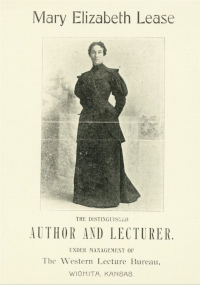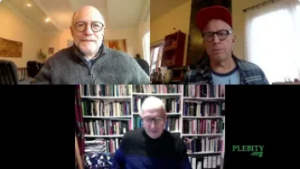What the 1880s Populist Revolt of Southern Farmers Can Teach Us Today
“Wall street owns the country. It is no longer a government of the people, by the people, and for the people, but a government of Wall Street, by Wall Street, and for Wall Street.” -Populist leader Mary Elizabeth Lease (circa 1890)
The word populism gets thrown around these days to mean many different things. But one particular social movement that occurred here in the U.S. and was known as the populist farmers revolt of the 1880s deserves special attention and has many lessons for us today.
The Reality of the Times: Post Civil-War
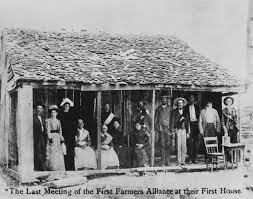 In the mid to late 1880s an overwhelming sense of helplessness had taken root among farmers of rural Texas and other parts of the post civil War South. Many of them lived in a seemingly endless cycle of poverty with no apparent way out. Some of them were dirt poor and some were small landowners, analogous to our own downwardly mobile middle-class. But poor or less poor, what they all shared was the reality of being trapped in a system of inescapable, ever-increasing debt.
In the mid to late 1880s an overwhelming sense of helplessness had taken root among farmers of rural Texas and other parts of the post civil War South. Many of them lived in a seemingly endless cycle of poverty with no apparent way out. Some of them were dirt poor and some were small landowners, analogous to our own downwardly mobile middle-class. But poor or less poor, what they all shared was the reality of being trapped in a system of inescapable, ever-increasing debt.
Particular to this case however, was that out of this bleak reality came something extraordinary – the farmers began to talk with each other, first singly and then eventually in large gatherings. They eventually founded an organization, the Farmers Alliance, and developed a system of travelling speakers who went from town to town and hosted large gatherings. The messages these speakers passed on about solidarity and collective strength struck a chord with the farmers, and their Alliance became a real phenomenon that grew beyond expectations. This movement became known as the populist farmers revolt and it spread like wildfire, first in Texas and then throughout the rural south. The movement spread among both white and black farmers and eventually the Farmers Alliance and the Colored Farmers’ Alliance together had membership in the millions.
Crop Lien System: Stage 1- Buying Supplies from the Merchant
Specifically, the system that had them trapped was known as the Crop Lien System. Farmers in this region had basically a single dependable cash crop, cotton. To grow the cotton they needed to buy seeds, farming implements, and of course all the staples of living they would need to survive until they could harvest and then sell their crop. To get these necessities the farmers had to go to the local merchant and make their purchases. This merchant would become the human face of the system in which they were effectively enslaved.
This process is described by Lawrence Goodwyn in his book The Populist Moment, A Short History of the Agrarian Revolt in America:
“The ‘system’ was the crop lien system. It defined with brualizing finality not only the day-to-day existence of most Southerners who worked the land, but also the narrowed possibilities of their entire lives.”
Farmers would go into the merchant’s store with a list of the items that were essential to them and to work out a deal that would allow them to continue to work for one more year. The merchant would consider their lists of items and arbitrarily decide what they would actually receive. Typically, after some back and forth they would be given some portion of their requests in exchange for signing a note to the merchant that recorded their debt. Cash transactions were virtually impossible for all of these farmers– they rarely had enough money. So in this way they began the year, and entered the first stage of the downward spiral of debt.
Crop Lien System: Stage 2 – Selling Their Crop
So, farmers went hat in hand to the merchant and in the end, they took what they were offered on the terms that were demanded of them, and then they went back to plant their crop. When harvest time came and the crop was finally sold they would return to the merchant and ‘settle up’. In theory the note they signed with the merchant would be repaid with the proceeds from selling their crop. This was a charade since it was perfectly understood that the farmers would never have earned enough to pay back the note. The merchant would tally up their balance and rewrite them a new note for a higher principal and at a high rate of interest, effectively pushing their growing debt down the road to the next season. Goodwyn points out “Farmers learned that the interest they were paying limited their lives in a new and terrible way; the rates imposed were frequently well in excess of 100 per cent annually, sometimes over 200 percent.”
This downward cycle repeated itself year after year as any possibility of paying off their debt became further and further out of reach. In the end, each individual farmer would have nothing left to pay off the debt except the parcels of land which many of them owned. Eventually that was the exchange: they would hand over the title to their land and become tenant farmers. At this point, all that was left was for the next generation to take their place and the cycle could continue.
Failure of the Political Two Party System
The political system of the time offered no help to these people. Much like today, the country in this post war period had become locked into a two party system where both parties had essentially become parties of business interests. Goodwyn describes the political environment captured by big business and Wall Street:
“Everywhere–North and South, among Republicans and Democrats–business and financial entrepreneurs had achieved effective control of a restructured American party system.”
The Rise of Collective Consciousness
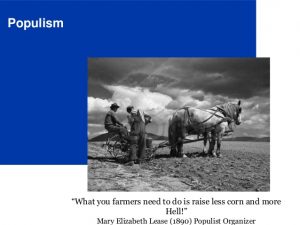
White Farmers had it Bad and Black Farmers had it Worse
Both white and black farmers realized that organizing and flexing their collective strength was their only hope. However, both political parties had become overtly business friendly as well as adopting racist strategies that effectively used the myths of shared ‘white’ identity and nostalgia for the lost cause of the confederacy to attract Southerners across class lines and to divide white farmers and Black farmers who in reality shared more than what kept them apart. Goodwyn explains:
“’Sectional, religious and racial loyalties and prejudices were used to organize the nation’s two major parties into vast coalitions that ignored the economic interests of millions.”
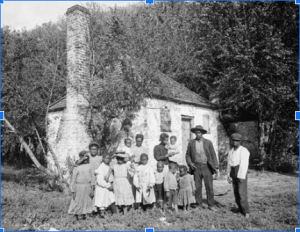 Like our identity politics of today, these strategies were calculated to prevent possibilities of class solidarity that might unite people against the dominant corporate and financial elites.
Like our identity politics of today, these strategies were calculated to prevent possibilities of class solidarity that might unite people against the dominant corporate and financial elites.
While there were some instances of cooperation between white and black farmers, overwhelmingly the existing race-based caste system overrode this and made even basic organizing far more difficult and perilous for blacks. The Farmer’s Alliance was a white’s only organization, black farmers were not allowed to join. Because of this the black farmers created their own organization, the Colored Farmers Alliance. What the whites could take for granted, however–the ability to gather in large groups to socialize and spread their political ideas–was largely impossible for the black farmers. The white farmer’s gatherings were huge and Goodwyn describes them like this:
“When a farm family’s wagon crested a hill en route to a Fourth of July ‘Alliance Day’ encampment and the occupants looked back to see thousands of other families trailed out behind them in wagon trains, the thought that ‘the Alliance is the people and the people are together’ took on transforming possibilities. Such a moment–and the Alliance experience was to yield hundreds of them–instilled hope in hundreds of thousands of people who had been without it.”
For the black farmers, any form of organizing had to be done out of the spotlight, covertly so as to avoid physical attacks. Where the whites openly gathered in large crowds, arriving in lines of wagons flying blue ribbons, the black farmers had to organize in small groups and secretly. In spite of the difficulties that they faced, the Black Farmers Alliance, also known as the Colored Farmers’ National Alliance and Cooperative Union, was hugely popular and by 1890 it had an extraordinary membership of over 1.2 million.
But the realities for both whites and blacks were similar. As Goodwyn outlines:
“A white farmer in South Carolina, between 1887 and 1895, bought goods and services from the furnishing merchant for $2,681.02 but was able to pay only $687.31, and finally he had to give his land to the merchant. A black farmer named Matt Brown, in Black Hawk, Mississippi, between 1884 and 1901, bought his supplies from the Jones store, kept falling further and further behind, and in 1905 the last entry in the merchant’s ledger is for a coffin and burial supplies.”
Forms of Cooperative Organization
The Farmers Alliance focused on innovations that would make it possible for them to buy their essential needs and seed their crop outside of the established system of merchants and corporate agents that was rigged against their interests. They set out to eliminate the merchant middleman and where they could to manufacture their own products or necessities. They found inventive concrete ways to do this – for example when the prices of the jute sacks they needed to wrap the cotton bales was artificially inflated, they fought back by boycotting jute and making their own versions out of cotton.
Difficulties and Failures
In the end the farmers were never able to completely eliminate the middlemen merchants who sold them goods on credit, or the buying agents who purchased their crops at artificially low levels. The merchants and the corporate powers behind them, including the banks and the railroads, had too tight a grip on the financial system. The banks controlled the availability of credit on which their cooperatives depended and the monopolistic railroads had full control over how, when, and at what price their product would be delivered to the rest of the country.
The farmers also lost in the war for public opinion. What we call now the mainstream media was firmly against the populists. It mocked them and relentlessly depicted them in the most negative light possible.
By 1892, the popularity of the Alliance and its huge numbers led to the creation of the political party known as The People’s Party. But even though this party grew to become the largest third party challenge to the two party system in our history, the farmer’s revolt was really already over when the party was formed. When the grassroots economic revolt of the farmers was eventually handed over to politicians this really marked the end of the movement.
The Farmers Alliance became the People’s Party and in spite of huge popularity it failed to carry out the original mandate of the movement. Political parties attract politicians, individuals who are skilled in deal making and compromise, who inevitably become preoccupied with their individual careers and who in the end do not stand firm in representing their actual constituents. The interests of the actual farmers were left behind.
Comparisons with Today
Let’s fast forward now to contemporary times. There is an interesting observation made by some that living in the modern age we’re more comfortable than the wealthiest royalty of the Middle Ages. And the point is made to suggest that we shouldn’t complain because we have it better than anyone ever before in history.
This is both partially true (certainly not for many poor people) and a distraction from the real issue. It is certainly true that the overall gains in productivity since the beginning of the industrial age mean that the whole pie available to humans is vastly bigger than it ever was in the past. And technology offers us simple luxuries like heat and unrestricted light after the sun goes down, that were unknown to the commoners of the past. That doesn’t change the fact that the lien and debt system that reduced the Southern farmers of the 1800s to no more than an exploitable resource is still very much with us today.
Many of the details of the populist movement that are specific to their time and place make it difficult for us to see the actual mechanism of the oppression and how it worked underneath the surface to bring us to where we are now. In A People’s History, Howard Zinn makes this point:
“…the industrial and political elites of North and South would take hold of the country and organize the greatest march of economic growth in human history. They would do it with the aid of, and at the expense of, black labor, white labor, Chinese labor, European immigrant labor, female labor, rewarding them differently by race, sex, national origin, and social class, in such a way as to create separate levels of oppression–a skillful terracing to stabilize the pyramid of wealth.”
If we strip away the outer appearances specific to the 1880s and take a clear, objective look at the actual mechanics of the credit lien system that led to the Farmers Alliance how does this compare with our present day? In fact, we will see that we are very much living a version of the same thing, albeit a velvet glove version where the superficial luxuries we enjoy mask the underlying realities.
Where the farmers had their merchant, in our case, we have a small number of corporate monopolies from which we have no choice but to purchase the staples of our modern existence. Where they needed shovels and hoes and seeds, we need cell phones, medical insurance and car loans. To gain any sort of professional career we need to accept enormous and life-long student debt. These items aren’t luxuries except in the most technical sense. Without them we are unable to participate in modern society, hold jobs, get educated or raise children.
Like the Southern farmers up against a fixed price on their crop, we sell ourselves into the job market as powerless individuals. This is reinforced by our culture of hyper-individualism which discourages all forms of group solidarity. Explicit policies of neoliberalism since the 1970s have crushed unions and collective bargaining. We have a euphemistically called ‘sharing economy’ where people work as gig workers– but are in fact just individuals bereft of any collective power, considered contractors rather than employees and who must accept whatever terms are dictated to them by the companies who pay them.
It is true that many of the farmers who participated in the revolt were small landowners. Due to the Homestead Act of 1862 it was possible for many people to claim 160 acres of land and as a result some of the Southern farmers had their own land when they first were pulled into the credit lien system. These landowner farmers were not rich. They were very similar to our own downwardly mobile middle-class. While they may have acquired the basics of human comfort they found themselves losing ground year after year. When they were no longer useful as workers the system reached out to squeeze away their last assets.
Our corporate and academic elites have adopted a new means of manipulating the terrible divisions of the racial caste system that separated the white farmers and the black farmers. The elites of our modern society have adopted the identitarianism of woke culture. This ideology supports the same age-old divide and conquer strategy that prevents the 99% from organizing around their genuine shared interests. Identity politics is the final pillar of social control by the dominant elites who have unsurprisingly encouraged and embraced this regressive ideology.
Our mainstream media, much like it did in the 1880s, molds elite public opinion and discredits any genuine class consciousness.
There is both much to admire and much to criticize in the populist movement as it developed through the South of the late 1800s. It was imperfect in many ways, and it can’t be denied that the farmers movement and its spokespeople were rife with racism and antisemitism. The farmers associated the merchants and the banks behind them as Jews. They widely believed the Jews controlled everything and were the puppet masters behind their oppression.
We began this article with a quote about Wall Street by Mary Lease, orator, leader and heroine of the farmers revolt. Let’s not ignore that the same Mary Lease also had this to say:
“Redemption money and interest-bearing bonds are the curse of civilization. We are paying tribute to the Rothchilds of England, who are but the agent of the Jews.”
Her complaints against Wall Street were correct. The farmers’ complaints against a system that was designed to slowly destroy them were justified. That they found a mistaken explanation for their predicament in blaming the Jews doesn’t take away the validity of their issues or the reality of the trap they were caught in.
It is a fatal mistake to dismiss the complaints of those farmers and their movement because they were antisemitic, or racist. The Southern farmers had valid complaints about a rigged system but their interpretation of what was behind it was tragically flawed. They saw Jews as the hidden controlling force behind everything. The white farmers also adhered to a racial caste system that defined blacks as lesser humans.
In modern times, it is the logic of Critical Race Theory or woke ideology which sees everything through an identitarian lens that divides us as the 99%. The tragedy is that the farmers and the modern woke both share a fundamental misunderstanding of cause. The first step to fixing a problem is to be able to name it correctly. Replace the words in the Critical Race Theory anti-bias presentations from ‘white supremacism’ to capitalism and it not only makes more sense but suddenly it also offers a path forward to work against the problem.
It is striking how if you follow the logic of woke antiracist training, the response to the farmers would just be to condemn them as antisemites or in Hilary Clinton’s words as ‘deplorables’. This is just a way to deflect attention from and ignore the actual reasons for their anger and sense of helplessness. We could try to work together to fix the underlying problems, or at least talk about them clearly and try to fix them. Then, as economic differences and the power differentials they represent were addressed, perhaps gradually the racism and bigotry would dissolve or at least lessen. But if you ignore the root problems, the reasons for the anger and the misunderstandings, and then incessantly demand that everything be seen through a racist lens, then you are only adding more racism and division. It is no different than trying to fight a fire by pouring kerosene on it.
Consider the rhetoric of the farmers, replace the word ‘Jews’ with the word ‘capitalists’ or ‘Rothschilds’ with ‘Wall Street’ and this would yield an accurate description of what was happening in their world. The farmers revolt ultimately failed in no small part because it was hobbled by these racist and antisemitic beliefs. The Black Farmers Alliance had over a million members but these million human beings and the power they represented were not allowed to join in solidarity with the white farmers even though they all wanted to arrive at the same end and collective solidarity was the only route to arriving there. Like so many times in history, including our own, ‘divide and conquer’ was the winning strategy. Both groups, unable to get past meaningless divisions, came out poorer in the end. The system of economic and class domination remained secure in every meaningful way right through to the present.
In contemporary times we see inequality has only continued to rise and has reached unprecedented levels. Our diminishing and downwardly mobile middle-class, forever unable to ‘get ahead’ in the way that was commonly expected thirty years ago has much in common with the land-owning farmers of the populist revolt. Labor unions have been destroyed. Gig workers are completely at the mercy of the employers. We pay into a ‘healthcare’ system like the farmers paid the merchants and each year we get deeper in debt until in the end we give over all our assets, just like the farmers handed over the title to their farms. Like them, we pay into the system throughout our whole lives until in the end biology catches up; the system waits patiently for us to inevitably fall ill and in the end it squeezes our last assets out of our hands to pay our final medical bills.
In A People’s History Zinn points out the great advances in productivity that technological innovation brought into the world. Consider this simple fact: “Before the Civil War it took 61 hours of labor to produce an acre of wheat. By 1900, it took 3 hours, 19 minutes.”
This is the sort of fact often highlighted by proponents of capitalism as proof of its success and efficacy. But the question leaps out, where did the benefits of this increased productivity go? The question isn’t whether we have a middle-class that has become marginally or even significantly better off than those at the bottom of the economy. The question is, where has the vast majority of this wealth that has been created since the beginning of the industrial age gone?
The populist farmers brilliantly identified the weak underbelly of the system, and sought to work against it by leveraging their collective purchasing and selling power. Our fundamental problems are not different than theirs. We have the same dilemma and also a way out if we can organize our own collective power as both consumers and workers. We are nothing as individual materialist consumers or atomized gig workers. If we can find common cause and put away the divisive labels we have enormous power.
See: How About a Coup Against Silicon Valley
Sources:
https://en.wikipedia.org/wiki/Farmers%27_Alliance
https://www.britannica.com/topic/Farmers-Alliance
http://www.nebraskastudies.org/en/1875-1899/roots-of-progressivism/farmers-alliance/
https://www.archives.gov/education/lessons/homestead-act
The People, No: A Brief History of Anti-Populism by Thomas Frank
The Populist Moment, A Short History of the Agrarian Revolt in America by Lawrence Goodwyn
A People’s History by Howard Zinn, chapter 11
https://www.jacobinmag.com/2020/09/populism-thomas-frank-the-people-no-review
http://projects.vassar.edu/1896/antisemitism.html
https://en.wikipedia.org/wiki/Colored_Farmers%27_National_Alliance_and_Cooperative_Union

